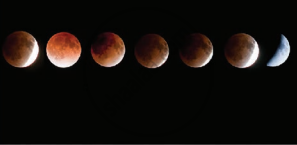Advertisements
Advertisements
Question
The Moon Io orbits Jupiter once in 1.769 days. The orbital radius of the Moon Io is 421700 km. Calculate the mass of Jupiter?
Solution
Kepler’s third law is used to find the mass of the planet
`"T"^2 = (4π^2)/("GM") ("R" + "h")^2`
M = `(4π^2)/"GT"^2 ("R" + "h")^2`
= `(4(3.14)^2 xx (421700 xx 10^3)^2)/(6.67 xx 10^-11 xx (1.769 xx 86400)^2)`
= `(39.4384 xx 7.499128631 xx 10^25)/(6.67 xx 10^-11 xx 2.336055469 xx 10^10)`
= `(295.7536 xx 10^25)/(1.5581)`
= 189.8169 × 1025
M = 1.898 × 1027 kg
APPEARS IN
RELATED QUESTIONS
Explain how Newton arrived at his law of gravitation from Kepler’s third law.
Explain how geocentric theory is replaced by heliocentric theory using the idea of retrograde motion of planets.
Explain in detail the Eratosthenes method of finding the radius of Earth.
Describe the measurement of Earth’s shadow (umbra) radius during the total lunar eclipse
The following photographs are taken from the recent lunar eclipse which occurred on January 31, 2018. Is it possible to prove that Earth is a sphere from these photographs?

A student was asked a question ‘why are there summer and winter for us? He replied as ‘since Earth is orbiting in an elliptical orbit, when the Earth is very far away from the Sun (aphelion) there will be winter, when the Earth is nearer to the Sun (perihelion) there will be winter’. Is this answer correct? If not, what is the correct explanation for the occurrence of summer and winter?
